
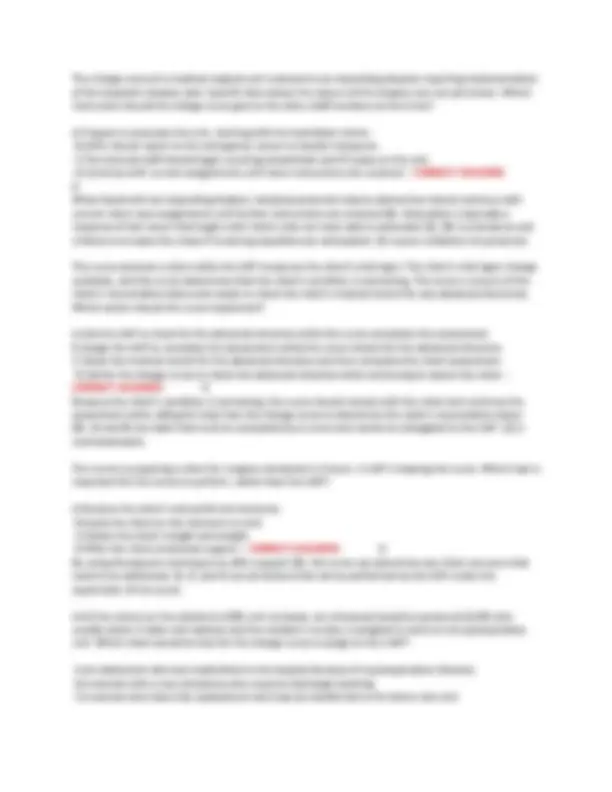
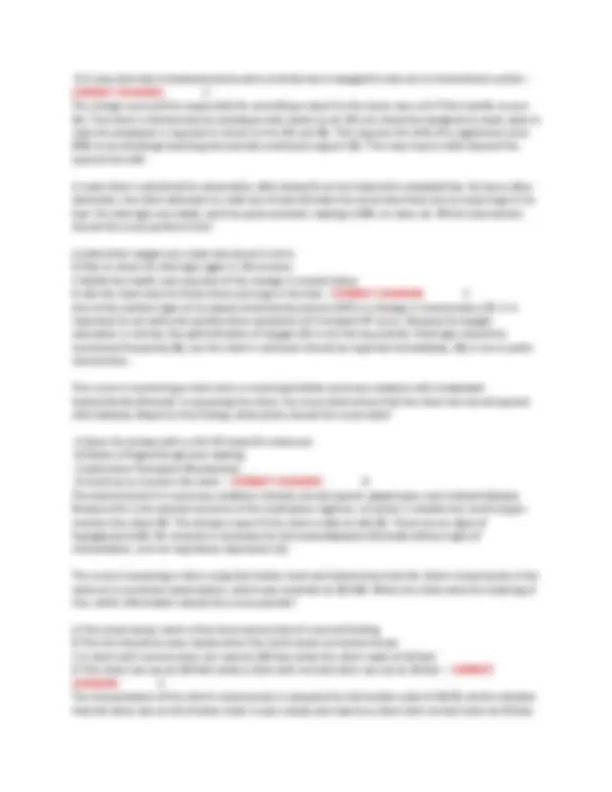
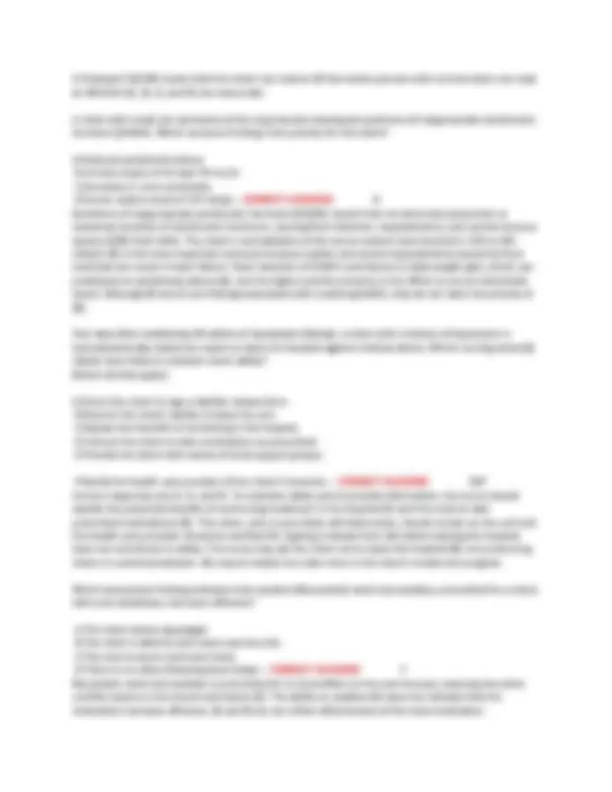
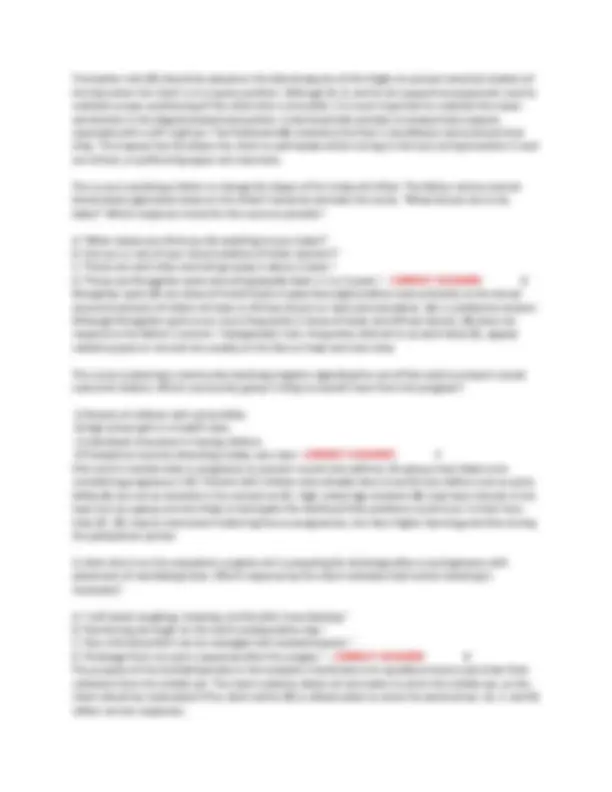
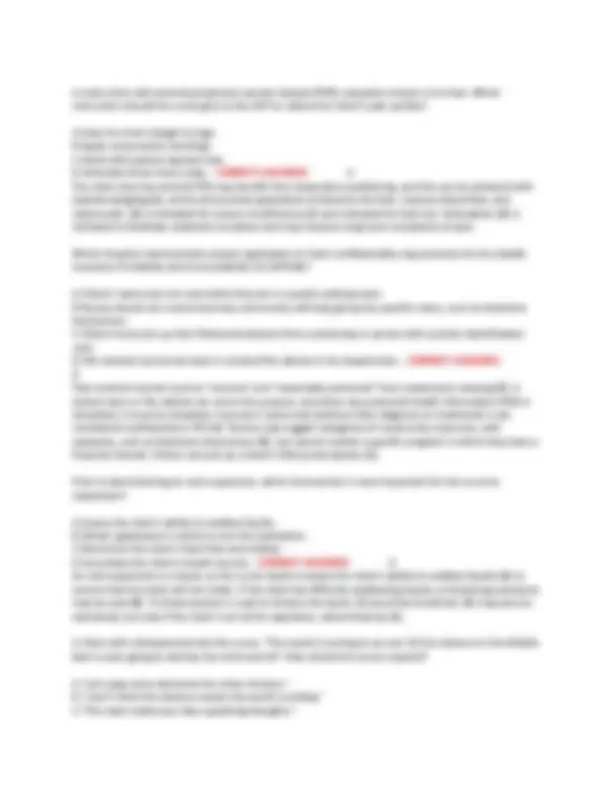
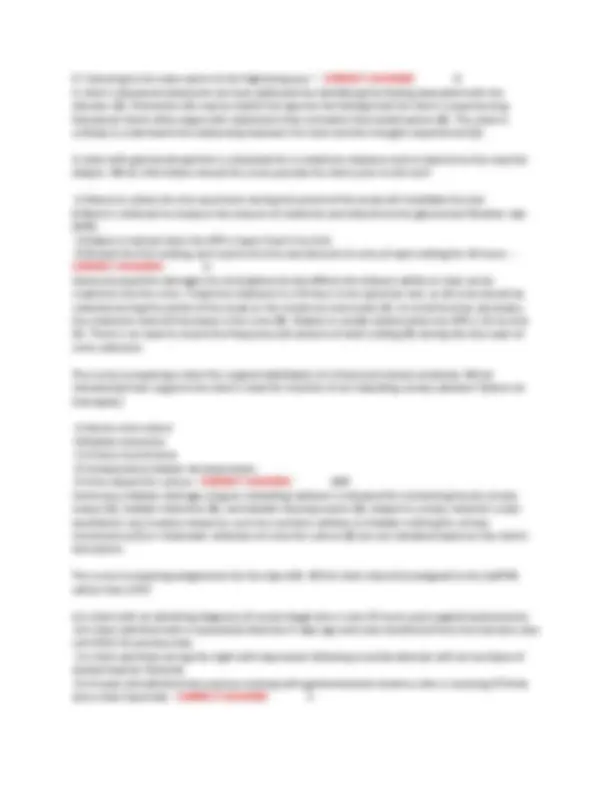
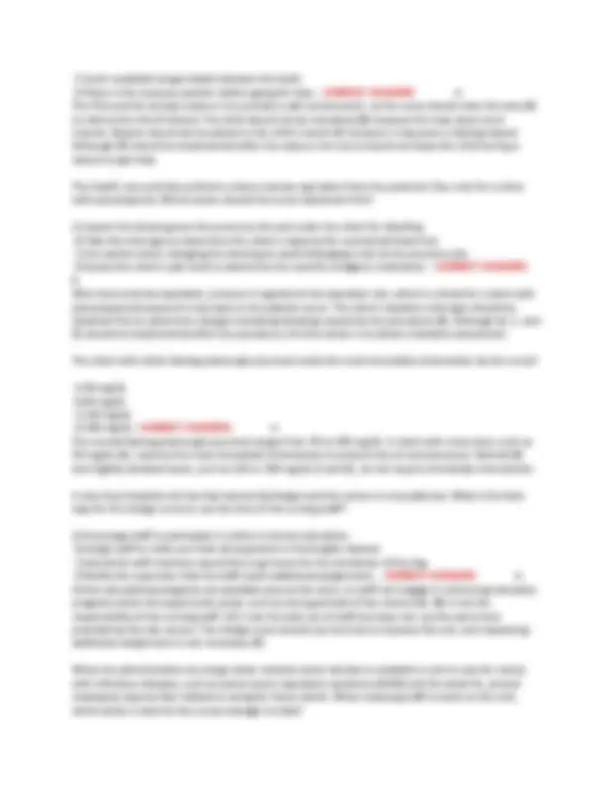
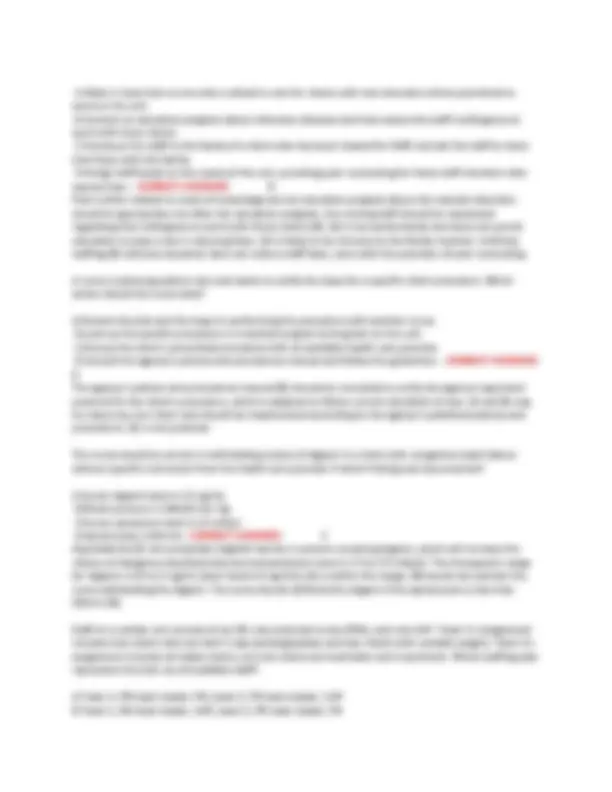
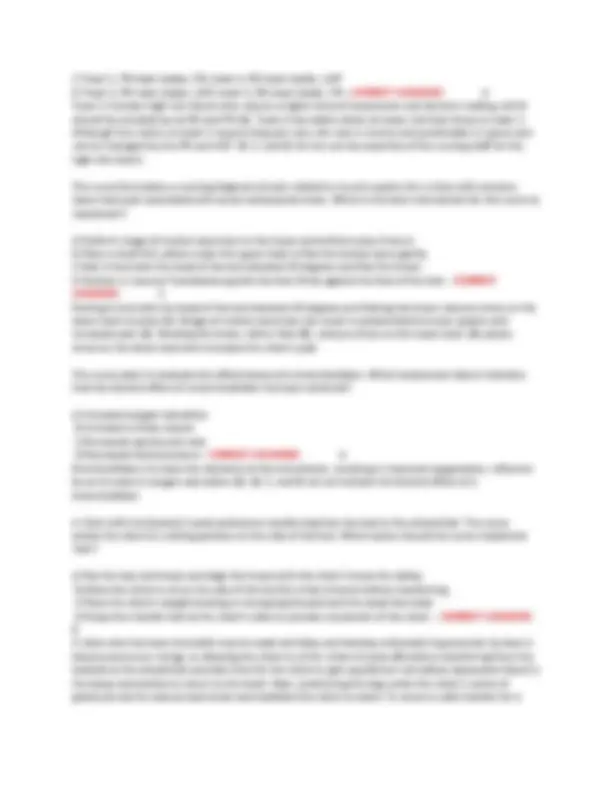
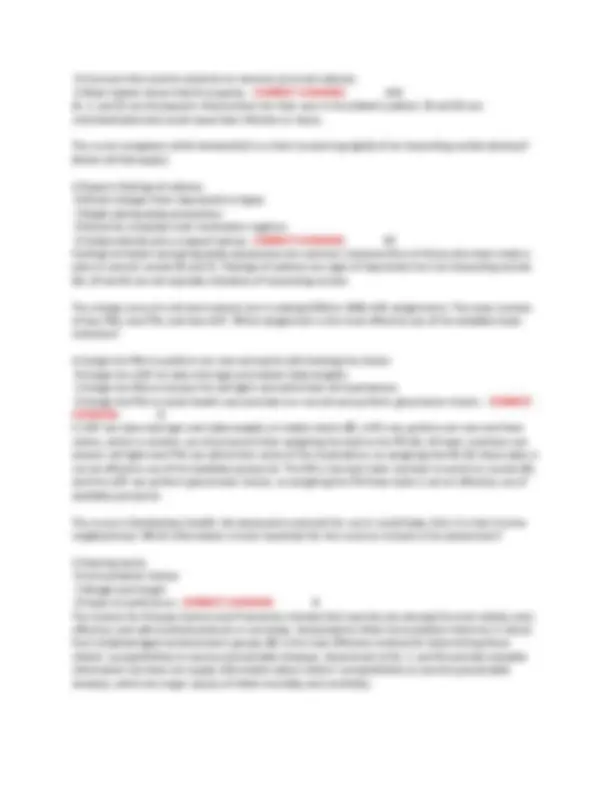
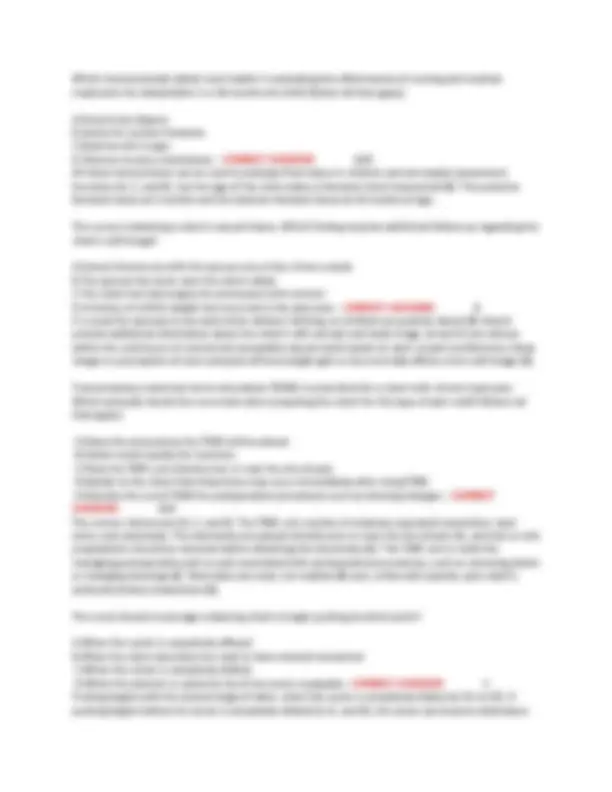
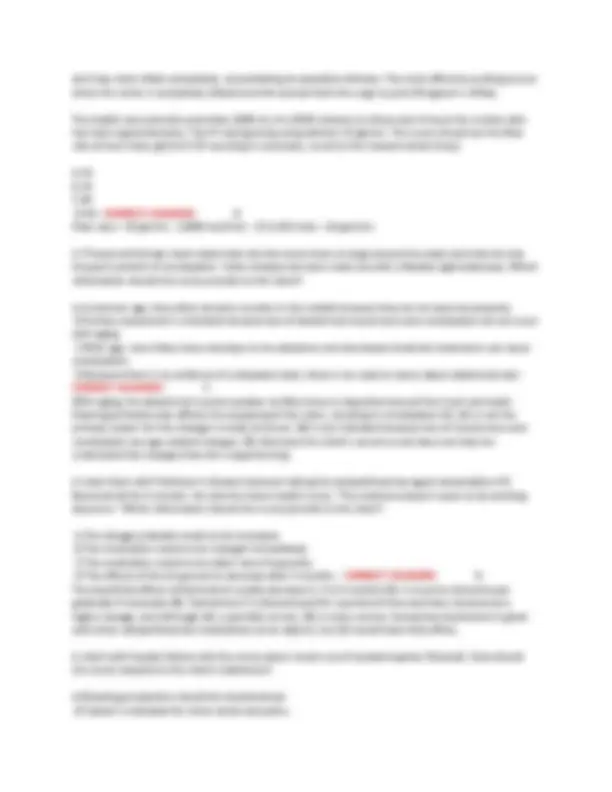
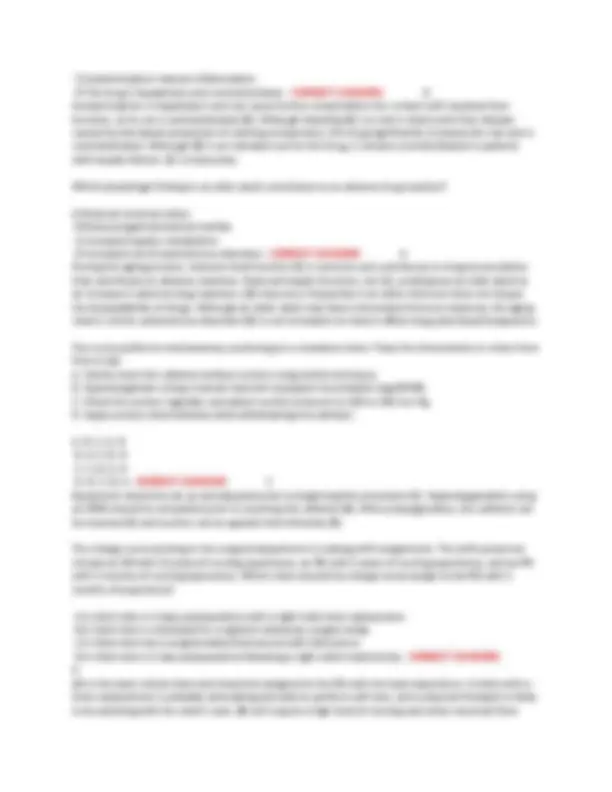
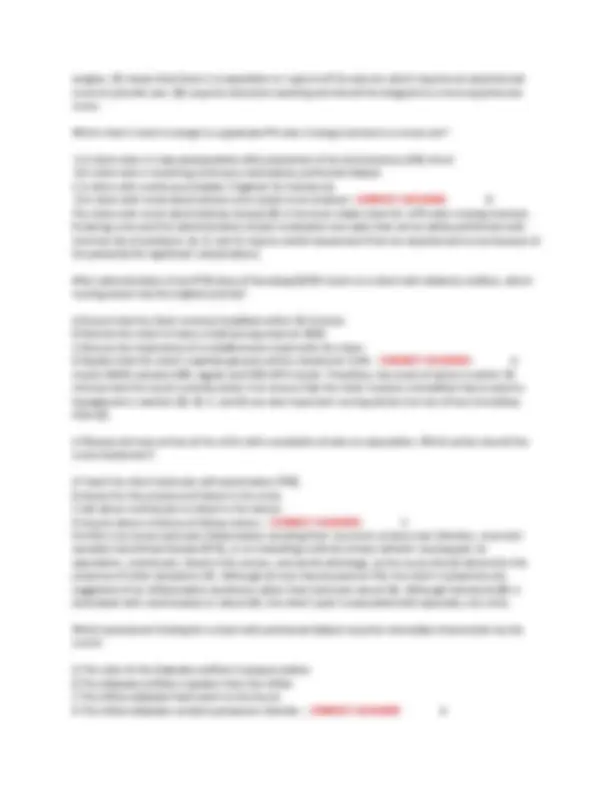
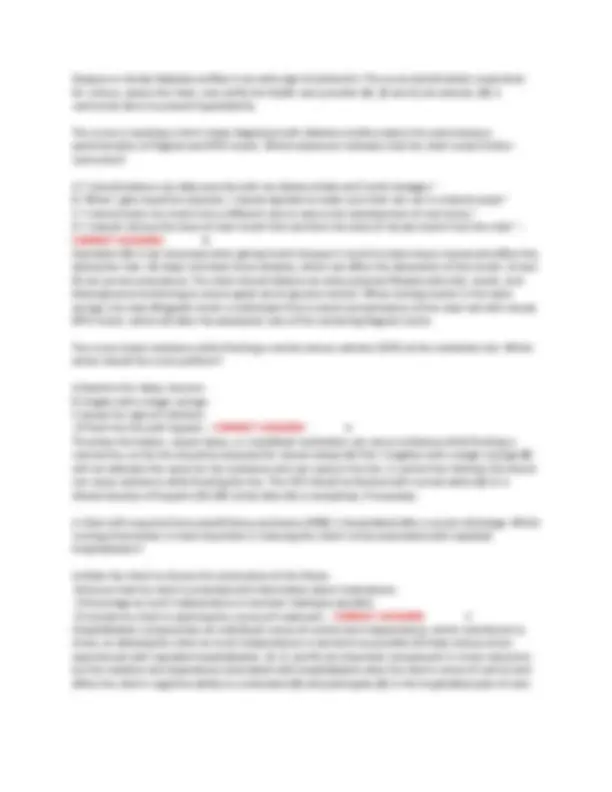
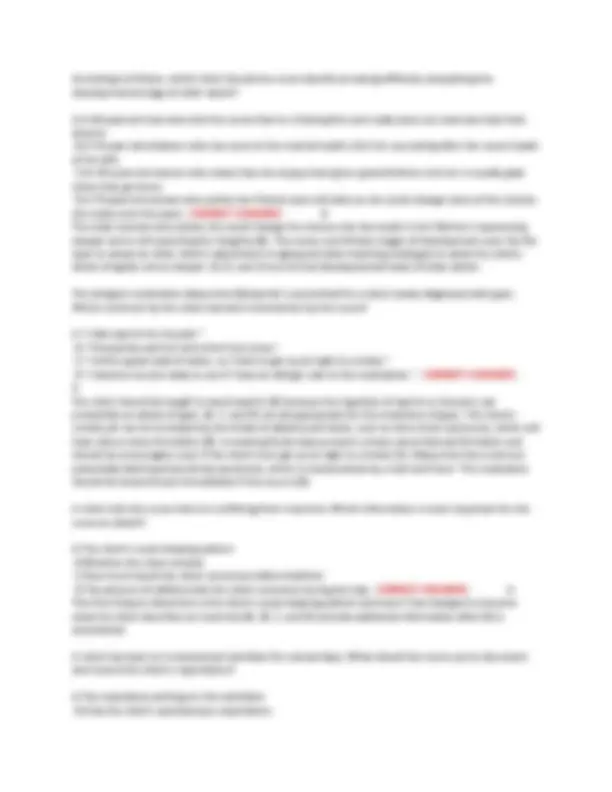
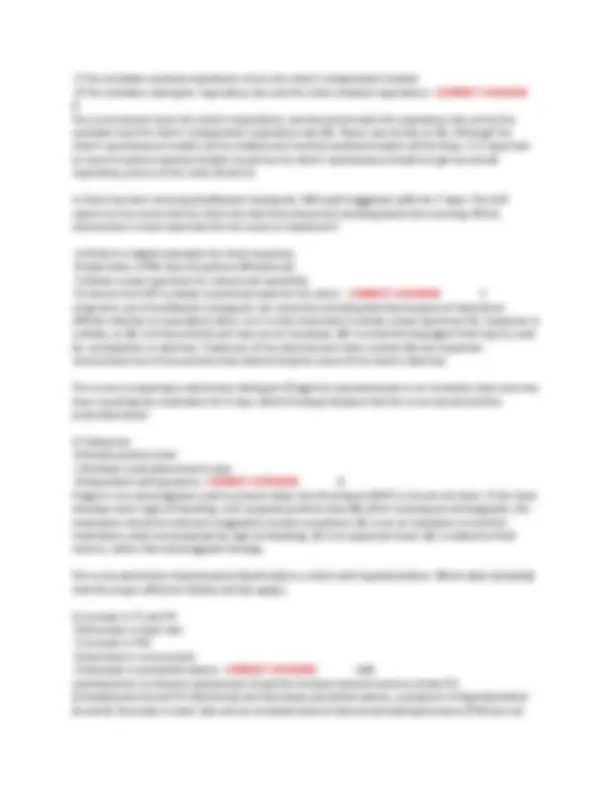
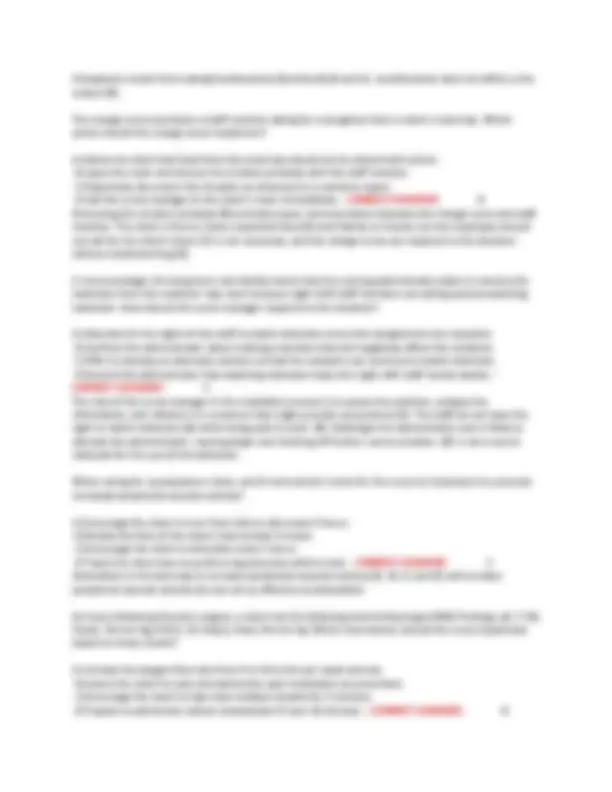
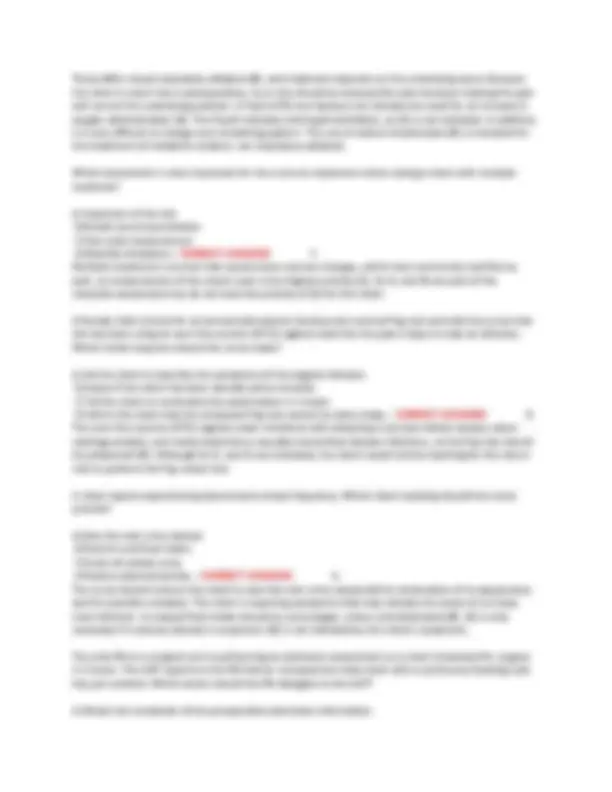
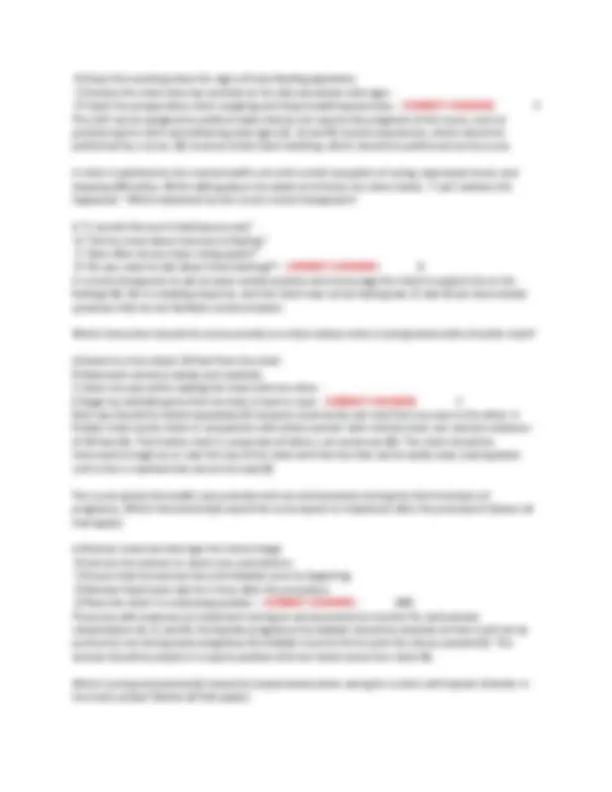
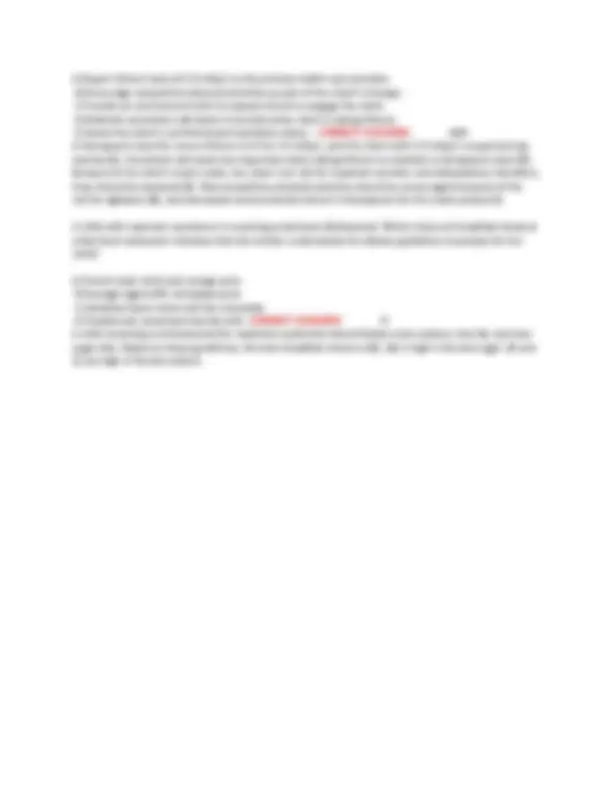


Study with the several resources on Docsity

Earn points by helping other students or get them with a premium plan


Prepare for your exams
Study with the several resources on Docsity

Earn points to download
Earn points by helping other students or get them with a premium plan
Community
Ask the community for help and clear up your study doubts
Discover the best universities in your country according to Docsity users
Free resources
Download our free guides on studying techniques, anxiety management strategies, and thesis advice from Docsity tutors
EXIT HESI -PN Exam A PRACTICE Exam Questions | 100% Correct Answers | Verified | Latest 2025/2026 Version
Typology: Exams
1 / 29

This page cannot be seen from the preview
Don't miss anything!






















A nurse who has recently completed orientation is beginning work in the labor and delivery unit for the first time. When making assignments, which client should the charge nurse assign to this new nurse?
A.A primigravida who is 8 cm dilated after 14 hours of labor B.A client scheduled for a repeat cesarean birth at 38 weeks' gestation C.A client being induced for fetal demise at 20 weeks' gestation D.A multiparous client who is dilated 5 cm and 50% effaced - CORRECT ANSWERS D The new nurse should be assigned the least complicated client to gain experience and confidence, as well as protect client safety. Of the clients available for assignment, (D) is progressing well and is the least complicated. (A, B and C) have actual or potential complications and should be assigned to a more experienced nurse.
A client with human immunodeficiency virus (HIV) infection has white lesions in the oral cavity that resemble milk curds. Nystatin (Mycostatin) preparation is prescribed as a swish and swallow. Which information is most important for the nurse to provide the client?
A.Oral hygiene should be performed before the medication. B.Antifungal medications are available in tablet, suppository, and liquid forms. C.Candida albicans is the organism that causes the white lesions in the mouth. D.The dietary intake of dairy and spicy foods should be limited. - CORRECT ANSWERS A HIV infection causes depression of cell-mediated immunity that allows an overgrowth of Candida albicans (oral moniliasis), which appears as white, cheesy plaque or lesions that resemble milk curds. To ensure effective contact of the medication with the oral lesions, oral liquids should be consumed and oral hygiene performed before swishing the liquid Mycostatin (A). (B and C) provide the client with additional information about the pathogenesis and treatment of opportunistic infections, but (A) allows the client to participate in self-care of the oral infection. Dietary restriction of spicy foods reduces discomfort associated with stomatitis, but restriction of dairy products is not indicated (D).
A client who is admitted with emphysema is having difficulty breathing. In which position should the nurse place the client?
A.High Fowler's position without a pillow behind the head B.Semi-Fowler's position with a single pillow behind the head C.Right side-lying position with the head of the bed elevated 45 degrees D.Sitting upright and forward with both arms supported on an over the bed table - CORRECT ANSWERS D Adequate lung expansion is dependent on deep breaths that allow the respiratory muscles to increase the longitudinal and anterior-posterior size of the thoracic cage. Sitting upright and leaning forward with the arms supported on an over the bed table (D) allows the thoracic cage to expand in all four directions and reduces dyspnea. A high Fowler's position does not allow maximum expansion of the posterior
lobes of the lungs (A). A semi-Fowler's position restricts expansion of the anterior-posterior diameter of the thoracic cage (B). Positioning a client on the right side with the head of the bed elevated (C) does not facilitate lung expansion.
A client with chronic renal insufficiency (CRI) is taking 25 mg of hydrochlorothiazide (HCTZ) PO and 40 mg of furosemide (Lasix) PO daily. Today, at a routine clinic visit, the client's serum potassium level is 4 mEq/L. What is the most likely cause of this client's potassium level?
A.The client is noncompliant with his medications. B.The client recently consumed large quantities of pears or nuts. C.The client's renal function has affected his potassium level. D.The client needs to be started on a potassium supplement. - CORRECT ANSWERS C The client has a normalized potassium level despite diuretic use (C). The kidney automatically secretes 90% of potassium consumed, but in chronic renal insufficiency (CRI), less potassium is excreted than normal. Therefore, the two potassium-wasting drugs, a thiazide diuretic and loop diuretic, are not likely to affect potassium levels. The normal potassium level is 3.5 to 5 mEq/L, and with a potassium level of 4 mEq/L, there is no reason to believe that the client is noncompliant with his treatment (A). Pears and nuts do not affect the serum potassium level (B). There is no need for a potassium supplement (D) because the client's potassium level is within the normal range.
A registered nurse (RN) delivers telehealth services to clients via electronic communication. Which nursing action creates the greatest risk for professional liability and has the potential for a malpractice lawsuit?
A.Participating in telephone consultations with clients B.Identifying oneself by name and title to clients in telehealth communications C.Sending medical records to health care providers via the Internet D.Answering a client-initiated health question via electronic mail - CORRECT ANSWERS C Sending medical records over the Internet, even with the latest security protection, creates the greatest risk for liability because of the high potential of breaching client confidentiality and the amount of information being transferred (C). Client confidentiality is protected by federal wiretapping laws making telephone consultation (A) a private and protected form of communication. By stating one's name and credentials in telehealth communication (B), one is taking responsibility for the encounter. E-mail initiated by the client (D) poses less risk than sending records via the Internet.
Which pathophysiologic response supports the contraindication for opioids, such as morphine, in clients with increased intracranial pressure (ICP)?
A.Sedation produced by opioids is a result of a prolonged half-life when the ICP is elevated. B.Higher doses of opioids are required when cerebral blood flow is reduced by an elevated ICP. C.Dysphoria from opioids contributes to altered levels of consciousness with an elevated ICP. D.Opioids suppress respirations, which increases Pco2 and contributes to an elevated ICP. - CORRECT ANSWERS D The greatest risk associated with opioids such as morphine (D) is respiratory depression that causes an increase in Pco2, which increases ICP and masks the early signs of intracranial bleeding in head injury. (A, B, and C) do not support the risks associated with opioid use in a client with increased ICP.
D.A man who had a cholecystectomy and currently has a nasogastric tube set to intermittent suction - CORRECT ANSWERS C The charge nurse will be responsible for providing a report to the home care unit if the transfer occurs (A). The client is infected and an employee who works on an OB unit should be assigned to clean cases in case the employee is required to return to the OB unit (B). This requires the skills of a registered nurse (RN) to do discharge teaching and provide emotional support (D). This may require skills beyond the level of this UAP.
A male client is admitted for observation after being hit on the head with a baseball bat. Six hours after admission, the client attempts to crawl out of bed and asks the nurse why there are so many bugs in his bed. His vital signs are stable, and the pulse oximeter reading is 98% on room air. Which intervention should the nurse perform first?
A.Administer oxygen per nasal cannula at 2 L/min. B.Plan to check his vital signs again in 30 minutes. C.Notify the health care provider of the change in mental status. D.Ask the client why he thinks there are bugs in the bed. - CORRECT ANSWERS C One of the earliest signs of increased intracranial pressure (ICP) is a change in mental status (C). It is important to act early and quickly when symptoms of increased ICP occur. Because his oxygen saturation is normal, the administration of oxygen (A) is not the top priority. Vital signs should be monitored frequently (B), but the client's confusion should be reported immediately. (D) is not a useful intervention.
The nurse is monitoring a client who is receiving bedside conscious sedation with midazolam hydrochloride (Versed). In assessing the client, the nurse determines that the client has slurred speech with diplopia. Based on this finding, what action should the nurse take?
A.Open the airway with a chin lift-head tilt maneuver. B.Obtain a fingerstick glucose reading. C.Administer flumazenil (Romazicon). D.Continue to monitor the client. - CORRECT ANSWERS D The desired level III in conscious sedation includes slurred speech, glazed eyes, and marked diplopia. Because this is the desired outcome of the medication regimen, no action is needed but continuing to monitor the client (D). The airway is open if the client is able to talk (A). There are no signs of hypoglycemia (B). No reversal is necessary for the benzodiazepine (Versed) without signs of oversedation, such as respiratory depression (C).
The nurse is assessing a client using the Snellen chart and determines that the client's visual acuity is the same as in a previous examination, which was recorded as 20/100. When the client asks the meaning of this, which information should the nurse provide?
A.This visual acuity result is five times worse that of a normal finding. B.This line should be seen clearly when the client wears corrective lenses. C.A client with normal vision can read at 100 feet what this client reads at 20 feet. D.This client can see at 100 feet what a client with normal vision can see at 20 feet. - CORRECT ANSWERS C The interpretation of the client's visual acuity is compared to the Snellen scale of 20/20, which indicates that the letter size on the Snellen chart is seen clearly and read by a client with normal vision at 20 feet.
A finding of 20/100 means that this client can read at 20 feet what a person with normal vision can read at 100 feet (C). (A, B, and D) are inaccurate.
A client with small cell carcinoma of the lung has also developed syndrome of inappropriate antidiuretic hormone (SIADH). Which outcome finding is the priority for this client?
A.Reduced peripheral edema B.Urinary output of at least 70 mL/hr C.Decrease in urine osmolarity D.Serum sodium level of 137 mEq/L - CORRECT ANSWERS D Syndrome of inappropriate antidiuretic hormone (SIADH) results from an abnormal production or sustained secretion of antidiuretic hormone, causing fluid retention, hyponatremia, and central nervous system (CNS) fluid shifts. The client's normalization of the serum sodium level (normal is 135 to 145 mEq/L) (D) is the most important outcome because sudden and severe hyponatremia caused by fluid overload can result in heart failure. Fluid retention of SIADH contributes to daily weight gain, which can predispose to peripheral edema (A), but the higher priority outcome is the effect on serum electrolyte levels. Although (B and C) are findings associated with resolving SIADH, they do not have the priority of (D).
Two days after swallowing 30 tablets of alprazolam (Xanax), a client with a history of depression is hemodynamically stable but wants to leave the hospital against medical advice. Which nursing action(s) is(are) most likely to maintain client safety? (Select all that apply.)
A.Direct the client to sign a liability release form. B.Restrict the client's ability to leave the unit. C.Explain the benefits of remaining in the hospital. D.Instruct the client to take medications as prescribed. E.Provide the client with names of local support groups.
F.Notify the health care provider of the client's intention. - CORRECT ANSWERS CDF Correct responses are (C, D, and F). To maintain safety and to provide information, the nurse should explain the potential benefits of continuing treatment in the hospital (C) and the need to take prescribed medications (D). This client, who is very likely self-destructive, should remain on the unit and the health care provider should be notified (F). Signing a release form (A) before leaving the hospital does not contribute to safety. The nurse may ask the client not to leave the hospital (B), but pressuring clients is unethical behavior. (E) may be helpful at a later time in this client's treatment program.
Which assessment finding indicates that nystatin (Mycostatin) swish and swallow, prescribed for a client with oral candidiasis, has been effective?
A.The client denies dysphagia. B.The client is afebrile with warm and dry skin. C.The oral mucosa is pink and intact. D.There is no reflux following food intake. - CORRECT ANSWERS C Mycostatin swish and swallow is prescribed for its local effect on the oral mucosa, reducing the white curdlike lesions in the mouth and larynx (C). The ability to swallow (A) does not indicate that the medication has been effective. (B and D) do not reflect effectiveness of the local medication.
Use the following calculation (B):
20 gtt/mL × (1000 mL/4 hr) × (1 hr/60 min) = 83 gtt/min
The RN is caring for a client who is in skeletal traction. Which activity should the RN assign to the PN?
A.Assess skeletal pins for infection. B.Assist the client with toileting. C.Establish thrombus prevention care. D.Evaluate pain management plan. - CORRECT ANSWERS B The PN can implement nursing care, such as (B). The PN assists the RN in the development of a teaching plan and reinforces information to the client according to the plan. (A, C, and D) are outside the scope of PN practice, but the PN can assist the RN in gathering data, implementing nursing care, and contributing to the plan of care under the supervision of the RN.
In conducting a routine assessment, which question should the nurse ask to determine a client's risk for open-angle glaucoma?
A."Have you ever been told that you have hardening of the arteries?" B."Do you frequently experience eye pain?" C."Do you have high blood pressure or kidney problems?" D."Does anyone in your family have glaucoma?" - CORRECT ANSWERS D Glaucoma has a definite genetic link, so clients should be screened for a positive family history, especially an immediate family member (D). (A and C) are not related to glaucoma. Glaucoma rarely causes pain (B), which is why screening is so important.
Which question is most relevant to ask the parents when obtaining the history of a 2-year-old child recently diagnosed with osteomyelitis?
A."Has your child had an ear infection recently?" B."Does your child seem resistant to toilet training?" C."Is your child a picky eater?" D."Do you have a family history of bone disorders?" - CORRECT ANSWERS A Osteomyelitis can be caused by internal infections, such as otitis media (A). (B and C) are normal developmental findings for a 2-year-old. Osteomyelitis is caused by a bacterial infection, so (D) is not relevant.
A client with hemiplegia who is on bed rest is turned to the supine position, and the nurse determines that the client's hips are externally rotated. Which intervention is most important for the nurse to implement?
A.Request a prescription for a bed board to provide increased back support. B.Reposition the client so that both feet are supported by the bed board. C.Move the trapeze bar to allow the client to pull with the upper extremities. D.Place trochanter rolls on the lateral aspects of the client's thighs. - CORRECT ANSWERS D
Trochanter rolls (D) should be placed on the lateral aspects of the thighs to prevent external rotation of the hips when the client is in a supine position. Although (A, B, and C) are supportive equipment used to maintain proper positioning of the client who is immobile, it is most important to maintain the lower extremities in the aligned anatomical position. A bed board (A) provides increased back support, especially with a soft mattress. The footboard (B) maintains the feet in dorsiflexion and prevents foot drop. The trapeze bar (C) allows the client to participate while turning in the bed, during transfers in and out of bed, or performing upper arm exercises.
The nurse is assisting a father to change the diaper of his 2-day-old infant. The father notices several bluish-black pigmented areas on the infant's buttocks and asks the nurse, "What did you do to my baby?" Which response is best for the nurse to provide?
A."What makes you think we did anything to your baby?" B."Are you or any of your blood relatives of Asian descent?" C."Those are stork bites and will go away in about 2 years." D."Those are Mongolian spots and will gradually fade in 1 or 2 years." - CORRECT ANSWERS D Mongolian spots (D) are areas of bluish-black or gray-blue pigmentation seen primarily on the dorsal area and buttocks of infants of Asian or African decent or dark-skinned babies. (A) is a defensive answer. Although Mongolian spots occur more frequently in those of Asian and African decent, (B) does not respond to the father's concern. Telangiectatic nevi, frequently referred to as stork bites (C), appear reddish-purple or red and are usually on the face or head and neck area.
The nurse is planning a community teaching program regarding the use of folic acid to prevent neural tube birth defects. Which community group is likely to benefit most from this program?
A.Parents of children with spina bifida B.High school girls in a health class C.Individuals interested in having children D.Postpartum women attending a baby care class - CORRECT ANSWERS C Folic acid is needed early in pregnancy to prevent neural tube defects; the group most likely to be considering pregnancy is (C). Parents with children who already have a neural tube defect such as spina bifida (A) are not as invested in the content as (C). High school age students (B) may have interest in the topic but as a group are less likely to anticipate the likelihood that problems could occur in their lives than (C). (D) may be interested if planning future pregnancies, but have higher learning priorities during the postpartum period.
A client who is on the outpatient surgical unit is preparing for discharge after a myringotomy with placement of ventilating tubes. Which response by the client indicates that further teaching is necessary?
A."I will avoid coughing, sneezing, and forceful nose blowing." B."Swimming can begin on the tenth postoperative day." C."Any mild discomfort can be managed with acetaminophen." D."Drainage from my ears is expected after the surgery." - CORRECT ANSWERS B The purpose of the ventilating tubes in the tympanic membrane is to equalize pressure and drain fluid collection from the middle ear. The tube's patency allows air and water to enter the middle ear, so the client should be reeducated if the client swims (B) or allows water to enter the external ear. (A, C, and D) reflect correct responses.
D."Listening to the news seems to be frightening you." - CORRECT ANSWERS D A client's delusional statements are best addressed by identifying the feeling associated with the delusion (D). Distraction (A) may be helpful but ignores the feelings that the client is experiencing. Delusional clients often argue with statements that contradict their belief system (B). The client is unlikely to understand the relationship between the news and the thoughts experienced (C).
A client with glomerulonephritis is scheduled for a creatinine clearance test to determine the need for dialysis. Which information should the nurse provide the client prior to the test?
A.Failure to collect all urine specimens during the period of the study will invalidate the test. B.Blood is collected to measure the amount of creatinine and determine the glomerular filtration rate (GFR). C.Dialysis is started when the GFR is lower than 5 mL/min. D.Discard the first voiding, and record the time and amount of urine of each voiding for 24 hours. - CORRECT ANSWERS A Glomerulonephritis damages the renal glomeruli and affects the kidney's ability to clear serum creatinine into the urine. Creatinine clearance is a 24-hour urine specimen test, so all urine should be collected during the period of the study or the results are inaccurate (A). As renal function decreases, the creatinine level will decrease in the urine (B). Dialysis is usually started when the GFR is 12 mL/min (C). There is no need to record the frequency and amount of each voiding (D) during the time span of urine collection.
The nurse is preparing a client for surgical stabilization of a fractured lumbar vertebrae. Which indication(s) best supports the client's need for insertion of an indwelling urinary catheter? (Select all that apply.)
A.Hourly urine output B.Bladder distention C.Urinary incontinence D.Intraoperative bladder decompression E.Urine sample for culture - CORRECT ANSWERS ABD Continuous bladder drainage using an indwelling catheter is indicated for monitoring hourly urinary output (A), bladder distention (B), and bladder decompression (D) related to urinary retention under anesthesia. Less invasive measures, such as a condom catheter or bladder training for urinary incontinence (C) or midstream collection of urine for culture (E) are not indicated based on the client's description.
The nurse is preparing assignments for the day shift. Which client should be assigned to the staff RN rather than a PN?
A.A client with an admitting diagnosis of menorrhagia who is now 24 hours post-vaginal hysterectomy B.A client admitted with a myocardial infarction 4 days ago who was transferred from the intensive care unit (ICU) the previous day C.A client admitted during the night with depression following a suicide attempt with an overdose of acetaminophen (Tylenol) D.A 4-year-old admitted the previous evening with gastrointestinal rotavirus who is receiving IV fluids and a clear liquid diet - CORRECT ANSWERS C
(C) requires communication skills and assessment skills beyond the educational level of a PN or UAP. Establishing a therapeutic, one on one relationship with a depressed client is beyond the scope of practice for a PN. In addition, Tylenol is extremely hepatotoxic and careful assessment is essential. (A, B, and D) could all be cared for by a PN under the supervision of the RN.
A 2-day postpartum mother who is breastfeeding asks, "Why do I feel this tingling in my breasts after the baby sucks for a few minutes?" Which information should the nurse provide?
A.This feeling occurs during feeding with a breast infection. B.This sensation occurs as breast milk moves to the nipple. C.The baby does not have good latch-on. D.The infant is not positioned correctly. - CORRECT ANSWERS B When the mother's milk comes in, usually 2 to 3 days after delivery, women often report they feel a tingling sensation in their nipples (B) when let-down occurs. (A, C, and D) provide inaccurate information.
A comatose client is admitted to the critical care unit and a central venous catheter is inserted by the health care provider. What is the priority nursing assessment before initiating IV fluids?
A.Pain scale B.Vital signs C.Breath sounds D.Level of consciousness - CORRECT ANSWERS C Before administering IV fluids through a central line, the nurse must first ensure that the catheter did not puncture the vessel or lungs. A chest radiograph should be obtained STAT, and the nurse should auscultate the client's breath sounds (C). (A, B, and D) are important assessment data but are not specifically related to insertion of a central venous catheter.
The nurse is correct in withholding an older adult client's dose of nifedipine (Procardia) if which assessment finding is obtained?
A.Blood pressure of 90/56 mm Hg B.Apical pulse rate of 68 beats/min C.Potassium level of 3.3 mEq/L D.Urine output of 200 mL in 4 hours - CORRECT ANSWERS A Nifedipine (Procardia) is a calcium channel blocker that causes a decrease in blood pressure. It should be withheld if the blood pressure is lowered, and 90/56 mm Hg is a low blood pressure for an adult male (A). A pulse rate less than 60 beats/min is an indication to withhold the drug (B). A potassium level of 3. mEq/L is low (normal, 3.5 to 5.0 mEq/L), but this finding does not affect the administration of Procardia (C). Urine output of more than 30 mL/hr, or 120 mL in 4 hours, is normal. Although a 200- mL output in 4 hours is slightly less than normal and warrants follow-up, it is not an indication to withhold a nifedipine (Procardia) dose (D).
A client hospitalized for meningitis is demonstrating nuchal rigidity. Which symptom is this client likely to be exhibiting?
A.Hyperexcitability of reflexes B.Hyperextension of the head and back
C.Insert a padded tongue blade between the teeth. D.Place in the recovery position before going for help. - CORRECT ANSWERS A The first priority during a seizure is to provide a safe environment, so the nurse should clear the area (A) to reduce the risk of trauma. The child should not be restrained (B) because this may cause more trauma. Objects should not be placed in the child's mouth (C) because it may pose a choking hazard. Although (D) should be implemented after the seizure, the nurse should not leave the child during a seizure to get help.
The health care provider performs a bone marrow aspiration from the posterior iliac crest for a client with pancytopenia. Which action should the nurse implement first?
A.Inspect the dressing over the puncture site and under the client for bleeding. B.Take the vital signs to determine the client's response for a potential blood loss. C.Use caution when changing the dressing to avoid dislodging a clot at the puncture site. D.Assess the client's pain level to determine the need for analgesic medication. - CORRECT ANSWERS B After bone marrow aspiration, pressure is applied at the aspiration site, which is critical for a client with pancytopenia because of a decrease in the platelet count. The client's baseline vital signs should be obtained first to determine changes indicating bleeding caused by the procedure (B). Although (A, C, and D) should be implemented after the procedure, the first action is to obtain a baseline assessment.
The client with which fasting plasma glucose level needs the most immediate intervention by the nurse?
A.50 mg/dL B.80 mg/dL C.110 mg/dL D.140 mg/dL - CORRECT ANSWERS A The normal fasting plasma glucose level ranges from 70 to 105 mg/dL. A client with a low level, such as 50 mg/dL (A), requires the most immediate intervention to prevent loss of consciousness. Normal (B) and slightly elevated levels, such as 110 or 140 mg/dL (C and D), do not require immediate intervention.
A very busy hospital unit has had several discharges and the census is unusually low. What is the best way for the charge nurse to use the time of the nursing staff?
A.Encourage staff to participate in online in-service education. B.Assign staff to make sure that all equipment is thoroughly cleaned. C.Ask which staff members would like to go home for the remainder of the day. D.Notify the supervisor that the staff needs additional assignments. - CORRECT ANSWERS A Online educational programs are available around the clock, so staff can engage in continuing education programs when the opportunity arises, such as during periods of low census (A). (B) is not the responsibility of the nursing staff. (C) is not the best use of staff and does not use the extra time provided by the low census. The charge nurse should use the time to improve the unit, and requesting additional assignments is not necessary (D)
When the administration at a large urban medical center decides to establish a unit to care for clients with infectious diseases, such as severe acute respiratory syndrome (SARS) and the avian flu, several employees express fear related to caring for these clients. When choosing staff to work on this unit, which action is best for the nurse-manager to take?
A.Make it clear that no one who is afraid to care for clients with rare disorders will be permitted to work on the unit. B.Conduct an education program about infectious diseases and then assess the staff's willingness to work with these clients. C.Introduce the staff to the family of a client who has been treated for SARS and ask the staff to share their fears with this family. D.Assign staff based on the needs of the unit, providing peer counseling for those staff members who express fear. - CORRECT ANSWERS B Fear is often related to a lack of knowledge and an education program about the relevant disorders would be appropriate, but after the education program, the nursing staff should be reassessed regarding their willingness to work with these clients (B). (A) is too authoritarian and does not permit education to play a role in reducing fears. (C) is likely to be intrusive to the family member. Arbitrary staffing (D) without education does not reduce staff fears, even with the provision of peer counseling.
A nurse is planning patient care and wants to verify the steps for a specific client procedure. Which action should the nurse take?
A.Review the plan and the steps in performing the procedure with another nurse. B.Look up the specific procedure in a medical surgical nursing text on the unit. C.Discuss the client's prescribed procedure with an available health care provider. D.Consult the agency's policies and procedures manual and follow the guidelines. - CORRECT ANSWERS D The agency's policies and procedures manual (D) should be consulted to verify the agency's approved protocol for the client's procedure, which is adapted to follow current standards of care. (A and B) may be resources, but client care should be implemented according to the agency's published policies and procedures. (C) is not practical.
The nurse would be correct in withholding a dose of digoxin in a client with congestive heart failure without specific instruction from the health care provider if which finding was documented?
A.Serum digoxin level is 1.5 ng/mL B.Blood pressure is 104/68 mm Hg C.Serum potassium level is 2.5 mEq/L D.Apical pulse is 68/min - CORRECT ANSWERS C Hypokalemia (C) can precipitate digitalis toxicity in persons receiving digoxin, which will increase the chance of dangerous dysrhythmias (normal potassium level is 3.5 to 5.5 mEq/L). The therapeutic range for digoxin is 0.8 to 2 ng/mL (toxic levels ≥2 ng/mL); (A) is within this range. (B) would not warrant the nurse withholding the digoxin. The nurse should withhold the digoxin if the apical pulse is less than 60/min (D).
Staff on a cardiac unit consists of an RN, two practical nurses (PNs), and one UAP. Team 1's assignment includes two clients who are both 1 day postangioplasty and two clients with unstable angina. Team 2's assignment includes all stable clients, but two clients are bedridden and incontinent. Which staffing plan represents the best use of available staff?
A.Team 1: RN team leader, PN; team 2, PN team leader, UAP B.Team 1, RN team leader, UAP; team 2, PN team leader, PN
client with hemiparesis (unilateral muscle weakness), a transfer belt (D) provides a secure hold to prevent sudden falls.
When the nurse-manager posts a schedule for volunteers to be on call, one staff member immediately signs up for all available 7-to-3 day shifts. Other staff members complain to the charge nurse that they were not permitted the opportunity to be on call for the day shift. What action should the nurse- manager implement?
A.Speak privately with the nurse. B.Hold a staff meeting to discuss this issue. C.Review the nurse's current salary. D.Nominate the nurse for employee of the month. - CORRECT ANSWERS A The nurse-manager should speak privately with the nurse (A) to assess the nurse's motives and to discuss allowing other team members the opportunity to be on call for the day shift. (B) might become confrontational. (C) is irrelevant. (D) is not warranted.
A 40-year-old office worker who is at 36 weeks' gestation presents to the occupational health clinic complaining of a pounding headache, blurry vision, and swollen ankles. Which intervention should the nurse implement first? A.Check the client's blood pressure. B.Teach her to elevate her feet when sitting. C.Obtain a 24-hour diet history to evaluate for the intake of salty foods. D.Assess the fetal heart rate. - CORRECT ANSWERS A The blood pressure (A) should be assessed first. Preeclampsia is a multisystem disorder, and women older than 35 years and have chronic hypertension are at increased risk. Classic signs include headache, visual changes, edema, recent rapid weight gain, and elevated blood pressure. (B, C, and D) can be done if the blood pressure is normal.
A client with acute renal failure (ARF) starts to void 4 L/day 2 weeks after treatment is initiated. Which complication is important for the nurse to monitor the client for at this time?
A.Diabetes insipidus B.Hypotension C.Hyperkalemia D.Uremia - CORRECT ANSWERS B During the transition from oliguria to the diuretic phase of acute renal failure, the tubule's inability to concentrate the urine causes osmotic diuresis, which places the client at risk for hypovolemia and hypotension (B). (A) is related to the secretion of antidiuretic hormone (ADH) and not specifically to the kidney function. Because of the excessive fluid loss, the client is at risk for potassium loss, not (C). (D) is characteristic of chronic renal failure with multiple body system involvement.
A mother of a 12-year-old boy states that her son is short and she fears that he will always be shorter than his peers. She tells the nurse that her grown daughter only grew 2 inches after she was 12 years of age. To provide health teaching, which question is most important for the nurse to ask this mother?
A."Is your son's short stature a social embarrassment to him or the family?" B."What types of foods do both your children eat now and what did they eat when they were infants?" C."Did any significant trauma occur with the birth of your son?"
D."Did your daughter also start her menstrual period at 12 years of age?" - CORRECT ANSWERS D Girls are expected to mature sexually and grow physically sooner than boys. Furthermore, girls only grow an average of 2 inches after menses begins (D). (A) is not appropriate at this time. The mother is worried that something is wrong with her son physically. (B) has less to do with stature than growth and development. (C) is not related to growth hormone deficiencies, which are idiopathic (without known causes).
The nurse calls the primary health care provider to report the status of a postsurgical client. Place the statements in the correct SBAR communication format. A. "Mr. Jones is experiencing pain of a 7 on a scale of 1 to 10. Vital signs are B/P 150/88, HR 90, and RR 26, with an O2 sat of 95%." B. "This is Mary Smith, RN, calling about Mr. Jones in room 325 at Memorial Hospital." C. "Mr. Jones had an open cholecystectomy yesterday and reports inadequate pain control with his current medication regimen since the surgery." D. "Would you like to make a change in his pharmacologic regimen?"
S = Situation and includes introduction of the nurse and client/setting (B). B = Background and includes the presenting complaint and relevant history (C). A = Assessment and includes current vital signs and other information (A). R = Recommendations and includes an explanation of why you are calling or a suggestion about which action should be taken (D).
A client with rhabdomyolysis tells the nurse about falling while going to the bathroom and lying on the floor for 24 hours before being found. Which current client finding is indicative of renal complications?
A.3+ protein in the urine B.Blood urea nitrogen >25 mg/dL C.Blood pH >7. D.Urine output, 2500 mL/day - CORRECT ANSWERS B Rhabdomyolysis is characterized by destruction of muscles that release myoglobin, causing myoglobinuria, which places the client at risk for acute renal failure, so an increased blood urea nitrogen (BUN) level (B) indicates a decrease in renal function. Blood in the urine from the accompanying breakdown of red blood cells contributes to proteinuria (A), an expected finding. Metabolic acidosis is the potential complication, not alkalosis (C). During the diuretic phase of acute renal failure, there can be a normal output volume (D) (approximately 2000 mL/day), which can result from IV fluid hydration.
What instruction(s) related to foot care is(are) appropriate for the client with type 1 diabetes mellitus? (Select all that apply.)
A.Use lanolin to moisturize the tops and bottoms of the feet. B.Soak the feet in warm water for at least 1 hour daily. C.Wash feet daily and dry well, particularly between the toes.
Which intervention(s) is(are) most helpful in evaluating the effectiveness of nursing and medical treatments for dehydration in a 36-month-old child? (Select all that apply.)
A.Record wet diapers. B.Assess for sunken fontanels. C.Examine skin turgor. D.Observe mucous membranes. - CORRECT ANSWERS ACD All these interventions can be used to evaluate fluid status in children and are helpful assessment functions (A, C, and D), but the age of the child makes a fontanel check impractical (B). The posterior fontanel closes at 2 months and the anterior fontanel closes at 18 months of age.
The nurse is obtaining a client's sexual history. Which finding requires additional follow-up regarding the client's self-image?
A.Sexual intercourse with the spouse occurs four times a week. B.The spouse has never seen the client naked. C.The client has had surgery for permanent birth control. D.A history of a 20-lb weight loss occurred in the past year. - CORRECT ANSWERS B It is usual for spouses to see each other without clothing, so a follow-up question about (B) should provide additional information about the client's self-concept and body image. (A and C) are choices within the continuum of normal and acceptable sexual needs based on each couple's preferences. Body image is a perception of one's physical self and weight gain or loss normally affects one's self-image (D).
Transcutaneous electrical nerve stimulation (TENS) is prescribed for a client with chronic back pain. Which action(s) should the nurse take when preparing the client for this type of pain relief? (Select all that apply.)
A.Shave the area where the TENS will be placed. B.Obtain small needles for insertion. C.Place the TENS unit directly over or near the site of pain. D.Explain to the client that drowsiness may occur immediately after using TENS. E.Describe the use of TENS for postoperative procedures such as dressing changes. - CORRECT ANSWERS ACE The correct choices are (A, C, and E). The TENS unit consists of a battery-operated transmitter, lead wires, and electrodes. The electrodes are placed directly over or near the site of pain (C), and hair or skin preparations should be removed before attaching the electrodes (A). The TENS unit is useful for managing postoperative pain or pain associated with postoperative procedures, such as removing drains or changing dressings (E). Electrodes are used, not needles (B) and, unlike with opioids, pain relief is achieved without drowsiness (D).
The nurse should encourage a laboring client to begin pushing at which point?
A.When the cervix is completely effaced B.When the client describes the need to have a bowel movement C.When the cervix is completely dilated D.When the anterior or posterior lip of the cervix is palpable - CORRECT ANSWERS C Pushing begins with the second stage of labor, when the cervix is completely dilated at 10 cm (C). If pushing begins before the cervix is completely dilated (A, B, and D), the cervix can become edematous
and may never dilate completely, necessitating an operative delivery. The most effective pushing occurs when the cervix is completely dilated and the woman feels the urge to push (Ferguson's reflex).
The health care provider prescribes 1000 mL of a D5W solution to infuse over 8 hours for a client who has had a appendectomy. The IV tubing being using delivers 15 gtt/mL. The nurse should set the flow rate at how many gtt/min? (If rounding is necessary, round to the nearest whole drop.)
Flow rate = 15 gtt/mL × (1000 mL/8 hr) × (1 hr/60 min) = 32 gtt/min
A 77-year-old female client states that she has never been so large around the waist and that she has frequent periods of constipation. Colon disease has been ruled out with a flexible sigmoidoscopy. Which information should the nurse provide to this client?
A.As women age, they often become rounder in the middle because they do not exercise properly. B.Further assessment is indicated because loss of abdominal muscle tone and constipation do not occur with aging. C.With age, more fatty tissue develops in the abdomen and decreased intestinal movement can cause constipation. D.Because there is no evidence of a diseased colon, there is no need to worry about abdominal size - CORRECT ANSWERS C With aging, the abdominal muscles weaken as fatty tissue is deposited around the trunk and waist. Slowing peristalsis also affects the emptying of the colon, resulting in constipation (C). (A) is not the primary reason for the changes in body structure. (B) is not indicated because loss of muscle tone and constipation are age-related changes. (D) dismisses the client's concerns and does not help her understand the changes that she is experiencing.
A male client with Parkinson's disease has been taking the antiparkinsonian agent amantadine HCl (Symmetrel) for 4 months. He tells the home health nurse, "The medicine doesn't seem to be working anymore." Which information should the nurse provide to this client?
A.The dosage probably needs to be increased. B.The medication needs to be changed immediately. C.The medication needs to be taken more frequently. D.The effects of this drug tend to decrease after 3 months. - CORRECT ANSWERS D The beneficial effects of Symmetrel usually decrease in 3 to 6 months (D). It must be discontinued gradually if necessary (B). Sometimes it is discontinued for a period of time and then resumed at a higher dosage, and although (A) is partially correct, (D) is more correct. Sometimes Symmetrel is given with other antiparkinsonian medications as an adjunct, but (C) would have little effect.
A client with hepatic failure tells the nurse about recent use of acetaminophen (Tylenol). How should the nurse respond to this client's statement?
A.Bleeding precautions should be implemented. B.Tylenol is indicated for minor aches and pains.